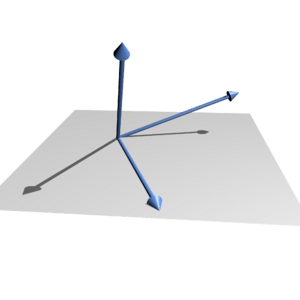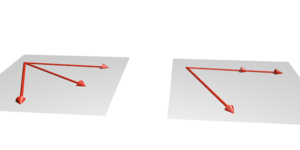Linear independence facts for kids
Linear independence is a cool idea from linear algebra, which is a type of math. It helps us understand how different "directions" or "movements" (called vectors) relate to each other. Imagine vectors as arrows that have both a length and a direction.
Every space where vectors live (called a vector space) has a special vector called the null vector. This is like an arrow with zero length, pointing nowhere. We can try to make this null vector by adding up other vectors, sometimes stretching or shrinking them first. This process is called a linear combination.
A group of vectors is called linearly independent if the only way to combine them to get the null vector is by making all the stretching/shrinking amounts zero. This means each vector in the group brings something totally new and can't be made by combining the others. If vectors are not linearly independent, they are called linearly dependent. This means at least one of them can be created by adding up the others.
Contents
What Are Vectors?
Vectors are like instructions for moving. For example, a vector could tell you to go "3 steps east and 2 steps north." In math, we often write them as lists of numbers, like `[3, 2]`. They are used in many areas, from physics to computer graphics.
What is Linear Independence?
Think of it like this: if you have a set of building blocks, are they all unique? If you have a red block, a blue block, and a green block, and you can't make the green block by combining the red and blue ones, then they are independent. In vector terms, if you have vectors that point in truly different directions, and none of them can be formed by adding or subtracting the others, they are linearly independent.
What is Linear Dependence?
Now, imagine you have a red block, a blue block, and a purple block. If you can make the purple block by putting the red and blue blocks together, then the purple block isn't "new" or "independent." It depends on the others. In the same way, if one vector can be made by combining other vectors in the group, then the group is linearly dependent. This means they don't all point in unique directions relative to each other.
Seeing it with Examples
Let's look at some examples to make this clearer.
- Imagine two arrows on a flat piece of paper. If they point in different directions, they are usually linearly independent. You can't make one by just stretching the other.
- If two arrows point in the exact same direction (or opposite directions), they are linearly dependent. You can make one by just stretching or shrinking the other.
- Now, imagine three arrows on that same piece of paper. If two of them point in different directions, and the third arrow can be made by combining those first two, then all three together are linearly dependent. This is because the third arrow doesn't add a new "direction" that isn't already covered by the first two.
Look at the images provided:
- The first image shows three arrows that are linearly independent. They point in directions that can't be made from each other. They help you reach any point in a 3D space.
- The second image shows three arrows that are linearly dependent. Even though there are three arrows, they all lie on the same flat surface (a plane). This means one of them could be made by combining the other two. They don't help you reach every point in a 3D space, only points on that specific flat surface.
For example, if you have four vectors, and one of them can be written as a combination of the other three (like one vector being nine times the first plus five times the second plus four times the third), then those four vectors together are linearly dependent. It doesn't matter which specific vector is the "extra" one; the whole group is dependent because they don't all bring unique information.
Why is This Important?
Understanding linear independence is super important in many fields:
- Computer Graphics: It helps computers figure out how to draw 3D objects and move them around.
- Engineering: Engineers use it to design stable structures or analyze electrical circuits.
- Data Science: It helps scientists understand relationships between different pieces of data.
- Physics: It's used to describe forces and movements.
It's a basic building block for solving more complex problems in math and science!
See also
In Spanish: Dependencia e independencia lineal para niños



